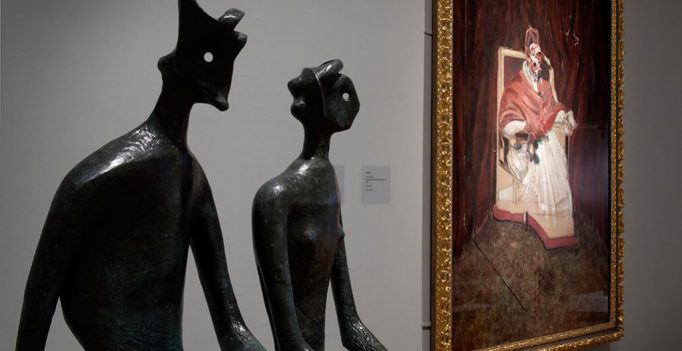ASHMOLEAN, 12 Sep 2013 to 19 Jan 2014, 8GBP
About the exhibition
This is a rare chance to see two of Britain’s greatest artists. Francis Bacon (28 October 1909 – 28 April 1992) and Henry Moore (30 July 1898 – 31 August 1986). The exhibition pieces are large, medium and small scale allowing the viewer to get a sense of breadth and depth from a very strong collection of work.
Figuration
The body and its infinite array of postures, actions, and gestures was for these artists an infinite source of inspiration. The human body is in and of itself a work of art without equal. As long as art has existed it has occupied a centrally dominant position for prehistoric, ancient, classical, modern, and contemporary artisans and artists. From The Venus of Willendorf, The Bronzes of Benin, Hellenic sculpture, Michelangelo’s David, Botticelli’s Venus and Gauguin’s many nudes to Valie Export and Franko B the very nature of the body and artists’ attempts to convey its subjectivity have given rise to such intrigue and beauty, here there is no exception.
Deformation
In appearance the figuration of Bacon and Moore are neither solely representational nor idealized, visually they share traits with primitivism and expressionism. Observe in Moore the expressionless faces, stylised hands and feet, elongated limbs, shrunken heads, and hollowed out spaces giving only a suggestion to bodily form. And in Bacon’s amorphous poses, deformed bodies and distorted faces allowing the viewer agency yet keeping them at a distance. In mammals the eyes and face along with body language grants the subject an inlet into the feeling or state of mind of a person or object. Both artists often actively with hold them, certainly a nod towards an appreciation of sheer form which creates a certain feeling of unease.
Iconoclasts
Bacon and Moore both painted and sculpted to gestural abstraction, their mediums used very frankly. Infer in both the limited colour, absence of decoration and pattern but the presence of strong, imposing lines and diagonals dominating the eye leading it forcefully, and in Bacon the charged colours of crimson and verdant greens fresh, striking and aggressive. These imbibe the work with strong fetish like qualities and energy that radiates through the very fabric of pure form.
Various works
Francis Bacon’s Triptych 1944 is extremely emotive. The foreground and background dissolve into a sea of blood like crimson wherein one can imagine a scene sinister arouses in the viewer charged interest. In isolation each canvas appears to be a different continuity yet also gives a sense of movement and time when viewed as a whole. The subjects are figures so removed from human figuration so as to turn their subject matter into pure form rather than object. They stand out like shards of bone emerging from a canvas of flesh. King and Queen 1953, Henry Moore is a striking bronze whose figures talk to ancient dynasties and the symbol of eternal human suffrage shared between man and woman – a truly compelling piece of work.
OUTLINE
Moore and Bacon at the Ashmolean: A triumphant collection of figurative abstraction realized in paint and sculpture, offering a rewarding array of scale, form and technique.
www.ashmolean.org/exhibitions/baconmoore/
written by: Colin Humphrey
